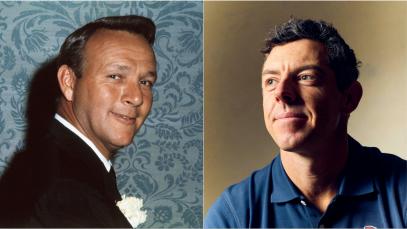BOMB IT LIKE A KID AGAIN
Padraig Harrington: 5 great speed-boosting drills for aging golfers

I play in pro-am tournaments almost every week, and I meet lots of regular golfers about my age—I'm 52—who love the game and have the goal of retiring soon and playing more golf. The problem is, many of these golfers can barely carry the ball 200 yards off the tee. In 15 years, they might struggle to fly it 160. If that happens, they're going to get frustrated and likely end up hating the game at a point in life when they should be enjoying it more than ever. It's one of the reasons I started the YouTube Channel, "Paddy's Golf Tips."
I wanted to offer some hope to golfers who are getting older and not hitting the ball the way they used to. I felt that way about my game for a while myself, so I did something about it. Working hard on speed with my coaching team Michael Jacobs, Pete Cowen, and Noel Fox, I’m now swinging faster and hitting it farther in my 50s than I was in my 30s—seriously!
On the following pages, I'll share some of the things I've learned about swing speed and how to combat the negative aspects of aging. If you're north of 50, you can't wait any longer to train for speed. If you sit on your arse, you risk aging into that golfer who only carries it 160. It's the old "use it or lose it" adage, and it's true when it comes to training those fast-twitch muscles necessary for speed. Read on and I'll help you bomb it like you used to. —WITH LUKE KERR-DINEEN
1. Grip the handle more in your fingers
Grip changes are universally loathed, but this adjustment is crucial for speed. Rest the handle of the club in the fingers of both hands instead of in your palms to provide more freedom to the wrists when you swing. To test it, hold the club in the fingers of your gloved hand and let your arm hang by your side. Note how freely you can move the club with just your hand and wrist. Your arm doesn't have to move, like it would if you grip the club in your palm.

Also, experiment with grip styles that promote more suppleness. I sometimes use a “double overlap" with my driver, where the pinky and ring finger of my right hand are on top of my gloved hand. Give it a try.
2. Practice stepping
I’ve played entire tournaments stepping laterally towards the target as I swing. I even did it in the U.S. Open at Winged Foot in 2006, when I had a putt on the last hole that would have got me into a play-off. Every time I was in heavy rough, I’d take a step with my left foot during my backswing to give me more speed and power in the rough.
Stepping like this also helps if you struggle to transfer weight into your lead foot at the optimal time in the swing. (Tip: It should happen a little sooner than you might think.)

Tee up a ball and address it with your feet together about a stride-length behind where you normally would. Stay that way as you take the club back but halfway into the backswing, take a big step toward your target, plant that foot, and then swing through. This drill might feel strange initially, but it's a great way to train for more speed and power.
3. Stand taller and more relaxed
How you address the ball greatly impacts your ability to swing the club fast and free.
One thing I learned a few years ago as I began chasing more speed is that you're way better off feeling relaxed at setup than you are if you stand rigidly over the ball—which is how I was taught as a kid to get into my address posture.
I now have no rigid lines and stand more upright, without sticking my butt out, with slightly rounded shoulders. And to stay loose, I’m always moving before I swing, especially my feet.

Standing taller and more relaxed when you address the ball will help the fluidity of your swing. Getting all tense and hunched over is a real speed killer.
4. Unlock your inner athlete
Golfers sometimes get lost in swing tips and thoughts, focusing on the right positions instead of remembering a pretty important aspect of hitting golf shots: You want to feel as athletic as possible and swing without much, if any, conscious thought. We instinctively know how to move to do all sorts of things, but in golf, our brain often gets in the way.
To unlock your body and get in a better frame of mind, it helps to perform other dynamic motions. For example, a right-hander who swings left-handed has no inhibition that would interfere with the raw, unconscious movement. Athleticism takes over. Another way to free yourself up is by throwing golf balls onto the range. You'll feel that stretch in your arms and body as you wind up, that big step towards the target before you throw, and an unwinding of your body around your posted front leg as you release the ball. That's just like an athletic golf swing!

5. Feel yourself sprint off the blocks
I can often tell how good most golfers are before they even swing. You just have to watch them move. However, I will say that bad golf swings aren't always the result of aging or poor physical fitness. Nowadays, many amateurs are getting their golf instruction on social media from people they’ve never heard of. It's another reason why I'm so passionate about Paddy's Golf Tips on YouTube—because it's information I learned myself, and believe in.
A common piece of terrible advice is to stay down and swing in the same posture you started in at address. When I see golfers trying that, they might manage to stay down, but they can’t move or turn freely. They’re in big trouble. Instead, I’d much rather see you rising up as the swing moves through impact. You want to squeeze your glutes and thrust up with your legs, which in turn whips the club through impact.

As you swing down, use your trail foot to push off the turf like a sprinter coming out of the blocks. That's how you pick up some serious swing speed and hit one way down the fairway alongside those young kids!
Final Thought: Train for more speed
The key piece to put all this together is to simply devote some time to training yourself to move fast. Like I said at the beginning, push yourself now to keep your speed from slowing down later in life. I used to do long speed training sessions on the range, but I found it was difficult to get those speeds to transfer to the golf course. Now, I’m more efficient with my speed training sessions.
One tool I use to help me with this are the SuperSpeed clubs. Yes, I’m an endorser of the products, but I truly believe they help. You don’t need to hit hundreds of balls to get faster. Just reserve five or 10 swings a few times a week to swinging as fast as you can. It doesn’t matter where the ball goes—you don’t even need to hit a ball. It’s simply about teaching your body to move faster.

Jensen Larson / @jensenlarson

.jpg.rend.hgtvcom.406.271.suffix/1704304024249.jpeg)
